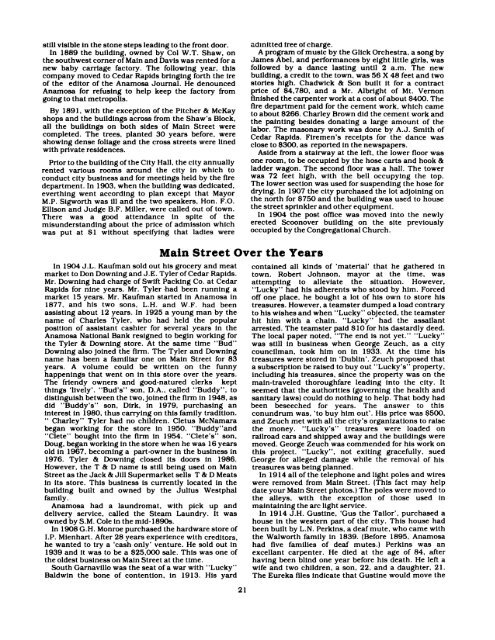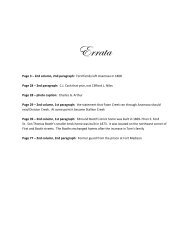Anamosa - A Reminiscence 1838 - 1988
The definitive history of the community of Anamosa, Iowa, USA
The definitive history of the community of Anamosa, Iowa, USA
Create successful ePaper yourself
Turn your PDF publications into a flip-book with our unique Google optimized e-Paper software.
still visible in the stone steps leading to the front door.<br />
In 1889 the building. owned by Col W.T. Shaw, on<br />
the southwest corner of Main and Davis was rented for a<br />
new baby carriage factory. The following year, this<br />
company moved to Cedar Rapids bringing forth the ire<br />
of the editor of the <strong>Anamosa</strong> Journal. He denounced<br />
<strong>Anamosa</strong> for refusing to help keep the factory from<br />
going to that metropolis.<br />
By 1891. with the exception of the Pitcher 81 McKay<br />
shops and the buildings across from the Shaw's Block,<br />
all the buildings on both sides of Main Street were<br />
completed. The trees. planted 30 years before. were<br />
showing dense foliage and the cross streets were lined<br />
with private residences.<br />
Prior to the building of the City Hall, the city annually<br />
rented various rooms around the city in which to<br />
conduct city business and for meetings held by the fire<br />
department. In 1903, when the building was dedicated.<br />
everthing went according to plan except that Mayor<br />
M.P. Sigworth was ill and the two speakers, I-Ion. F.O.<br />
Ellison and Judge B.F. Miller, were called out of town.<br />
There was a good attendance in spite of the<br />
misunderstanding about the price of admission which<br />
was put at S1 without specifying that ladies were<br />
admitted free ofcharge.<br />
A program of music by the Glick Orchestra. a song by<br />
James Abel. and performances by eight little girls. was<br />
followed by a dance lasting until 2 a.m. The new<br />
building. a credit to the town. was 56 X 48 feet and two<br />
stories high. Chadwick Gr Son built it for a contract<br />
price of $4.780. and a Mr. Albright of Mt. Vernon<br />
finished the carpenter work at a cost of about $400. The<br />
fire department paid for the cement work, which came<br />
to about $266. Charley Brown did the cement work and<br />
the painting besides donating a large amount of the<br />
labor. The masonary work was done by A.J. Smith of<br />
Cedar Rapids. Firemen's receipts for the dance was<br />
close to 3300. as reported in the newspapers.<br />
Aside from a stairway at the left, the lower floor was<br />
one room, to be occupied by the hose carts and hook 8!<br />
ladder wagon. The second floor was a hall. The tower<br />
was 72 feet high. with the bell occupying the top.<br />
The lower section was used for suspending the hose for<br />
drying. In 1907 the city purchased the lot adjoining on<br />
the north for $750 and the building was used to house<br />
the street sprinkler and other equipment.<br />
In 1904 the post office was moved into the newly<br />
erected Scoonover building on the site previously<br />
occupied by the Congregational Church.<br />
Main Street Over the Years<br />
In 1904 J .L. Kaufman sold out his grocery and meat<br />
market to Don Downing and J.E. Tyler of Cedar Rapids.<br />
Mr. Downing had charge of Swift Packing Co. at Cedar<br />
Rapids for nine years. Mr. Tyler -had been running a<br />
market 15 years. Mr. Kaufman started in <strong>Anamosa</strong> in<br />
1877. and his two sons. L.H. and W.F. had been<br />
assisting about 12 years. In 1925 a young man by the<br />
name of Charles Tyler. who had held the popular<br />
position of assistant cashier for several years in the<br />
<strong>Anamosa</strong> National Bank resigned to begin working for<br />
the Tyler 81 Downing store. At the same time “Bud"<br />
Downing also joined the finn. The Tyler and Downing<br />
name has been a familiar one on Main Street for 83<br />
years. A volume could be written on the funny<br />
happenings that went on in this store over the years.<br />
The frlendy owners and good-natured clerks kept<br />
things ‘lively’. "Bud's" son. D.A.. called "Buddy". to<br />
distinguish between the two. joined the firm in 1948. as<br />
did "Buddy's" son. Dirk. in 1979, purchasing an<br />
interest in 1980. thus carrying on this family tradition.<br />
" Charley" Tyler had no children. Cletus McNamara<br />
began working for the store in 1950. “Buddy"and<br />
"Clete" bought into the firm in 1954. “Clete's" son.<br />
Doug. began working in the store when he was 16 years<br />
old in 1967. becoming a part-owner in the business in<br />
1976. Tyler & Downing closed its doors in 1986.<br />
However. the T 8: D name is still being used on Main<br />
Street as the Jack G: Jill Supermarket sells T & D Meats<br />
in its store. This business is currently located in the<br />
building built and owned by the Julius Westphal<br />
farnily.<br />
<strong>Anamosa</strong> had a laundromat. with pick up and<br />
delivery service. called the Steam Laundry. It was<br />
owned by S.M. Cole in the mid-1890s.<br />
In 1908 G.H. Monroe purchased the hardware store of<br />
l.P. Mienhart. After 28 years experience with creditors.<br />
he wanted to try a ‘cash-only‘ venture. I-Ie sold out in<br />
1939 and it was to be a $25,000 sale. This was one of<br />
the oldest business on Main Street at the time.<br />
South Garnaviilo was the seat of a war with "Lucky"<br />
Baldwin the bone of contention. in 1913. His yard<br />
contained all kinds of ‘material' that he gathered in<br />
town. Robert Johnson, mayor at the time. was<br />
attempting to alleviate the situation. However,<br />
"Lucky" had his adherents who stood by him. Forced<br />
off one place, he bought a lot of his own to store his<br />
treasures. However, a teamster dumped a load contrary<br />
to his wishes and when "Lucky" objected. the teamster<br />
hit him with a chain. "Lucky" had the assailant<br />
arrested. The teamster paid S 10 for his dastardly deed.<br />
The local paper noted. "The end is not yet." "Lucky"<br />
was still in business when George Zeuch, as a city<br />
councilman. took him on in 1933. At the time his<br />
treasures were stored in ‘Dublin’. Zeuch proposed that<br />
a subscription be raised to buy out “Lucky's" property.<br />
including his treasures. since the property was on the<br />
main-traveled thoroughfare leading into the city. It<br />
seemed that the authorities [governing the health and<br />
sanitary laws) could do nothing to help. That body had<br />
been beseeched for years. The answer to this<br />
conundrum was. ‘to buy him out‘. His price was S500.<br />
and Zeuch met with all the city's organizations to raise<br />
the money. "Lucky's" treasures were loaded on<br />
railroad cars and shipped away and the buildings were<br />
moved. George Zeuch was commended for his work on<br />
this project. "Lucky". not exiting gracefully, sued<br />
George for alleged damage while the removal of his<br />
treasures was being planned.<br />
In 1914 all of the telephone and light poles and wires<br />
were removed from Main Street. (This fact may help<br />
date your Main Street photos.) The poles were moved to<br />
the alleys. with the exception of those used in<br />
maintaining the arc light service.<br />
In 1914 J.H. Gustine, ‘Gus the Tailor‘, purchased a<br />
house in the western part of the city. This house had<br />
been built by L.N. Perkins. a deaf mute. who came with<br />
the Walworth family in 1839. (Before 1895. <strong>Anamosa</strong><br />
had five families of deaf mutes.) Perkins was an<br />
excellant carpenter. I-Ie died at the age of 84. after<br />
having been blind one year before his death. 1-le left a<br />
wife and two children. a son. 22. and a daughter. 21.<br />
The Eureka files indicate that Gustine would move the



